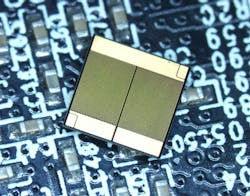Researchers built what they claim is the first half-bridge circuit in a single 600-volt chip. The voltage regulator could go a long way in the development of more efficient and smaller on-board chargers in electric vehicles.
The device, unveiled this week by the Fraunhofer Institute for Applied Solid State Physics, is a vital component of power converters, which are used universally to control the flow of power into tablets, washing machines, and anything else with a power cord. In electric cars, the voltage regulator could help shorten battery charging time.
The device's hallmark, the researchers say, is that all its infinitesimal parts share the same slab of gallium nitride, also known as GaN, an advanced semiconductor that inherently handles higher voltages and temperatures than traditional silicon. That enables vastly faster switching speeds, which only hit around 30 MHz in many current devices.
"A switching frequency of up to 3 MHz allows us to achieve a much greater power density," said Richard Reiner, a research associate in Fraunhofer's power electronics unit, in a statement. "This is very important in areas such as [electric mobility], where many converters which are as efficient as possible have to be fitted in very little space."
Faster switching speeds have a major payoff: Power engineers can make converters with smaller inductors and capacitors, bulky passive components that temporarily store electricity. The benefits get passed down to electric vehicle companies, which can buy smaller, lighter, more efficient electronics for charging batteries.
The layout of the monolithic chip includes two GaN transistors grown on silicon substrates, as well as a pair of diodes that suppress sudden voltage spikes from the power supply. The layout also helps to minimize negative effects like line impedance, improving the electrical switching characteristics.
The researchers demonstrated the technology last year in a down converter operating from 400 to 200 volts at a switching frequency of 3 MHz. Fraunhofer is demonstrating the new half-bridge circuit at Power Conversion and Intelligent Motion conference in Nuremberg next week.
About the Author
James Morra
Senior Editor
James Morra is the senior editor for Electronic Design, covering the semiconductor industry and new technology trends, with a focus on power electronics and power management. He also reports on the business behind electrical engineering, including the electronics supply chain. He joined Electronic Design in 2015 and is based in Chicago, Illinois.

